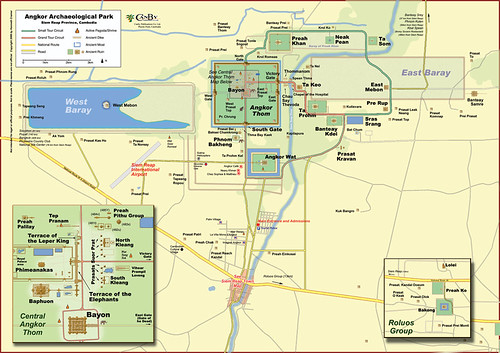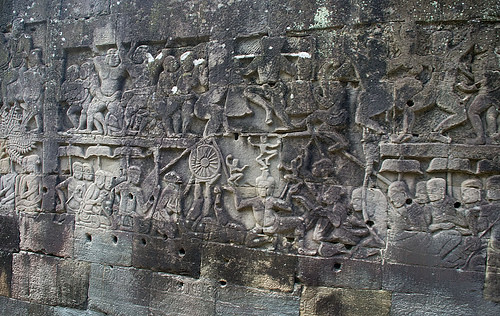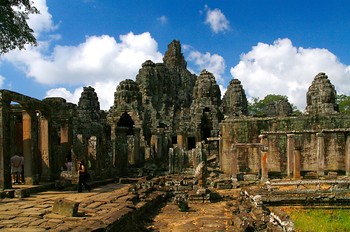Travel and Tourism in Cambodia: A Macro View
Although wedged between Thailand, Laos and Vietnam—competitive emerging market destinations, Cambodia possesses exceptional tourism assets and unparalleled opportunities, led by its World Heritage gem in Siem Reap—Angkor Wat . Fueled by non-trivial cash flows from Foreign Direct Investment along with hefty Government initiatives to increase capability, tourism investment and growth of visitors has significantly increased in Cambodia since the mid-1990s after the re-instatement of King Sihanouk. Due to limited but ongoing infrastructure improvements, there are currently three major tourist destinations in Cambodia: Phnom Penh (Capital City), Siem Reap (Cultural Heritage) and Sihanoukville (Beach). As can be seen in the graph below, Siem Reap contains the largest capacity for accomodation:
| Asia-Pacific Hotel Industry – October 2010 – Supply Structure | |||||
| Figure 8: Cambodia’s accommodation capacity, by region, 2009 | |||||
| Destination | Hotels | Hotel rooms | Guesthouses | Guesthouse rooms | |
| Phnom Penh |
159 |
6,920 |
355 |
5,648 |
|
| Siem Reap |
117 |
8,675 |
225 |
2,929 |
|
| Coastal area |
59 |
2,206 |
169 |
2,463 |
|
| Ecotourism area |
22 |
781 |
61 |
749 |
|
| Other |
73 |
2,770 |
341 |
2,787 |
|
| Total |
430 |
21,352 |
1,151 |
14,576 |
|
| Source: Cambodian Ministry of Tourism | |||||
Of all international visitors to Cambodia, ~50% visit the province of Siem Reap, making it the top single destination of the country. Since 2003 (when official tracking of tourist figures began), the number of arrivals to Siem Reap has grown faster than the other two destinations, resulting in an increase of market share for Siem Reap:
| 2005 | 2006 | % of total 2006 | 2007 (e) | % of total 2007 | % change 2005-07 | |
| Phnom Penh and other destinations | 744,806 | 843,531 | 49.6 | 855,147 | 42.4 | 14.8 |
| Siem Reap Province | 676,809 | 856,510 | 50.4 | 1,160,082 | 57.6 | 71.4 |
| Total | 1,421,615 | 1,700,041 | 100.0 | 2,015,229 | 100.0 | 41.8 |
However, the average length of stay in Siem Reap, as of 2007, is reported to be only 1.7 nights. Since 2003, the primary source market to Cambodia has been South Korea (particularly Kim, Youngsun), with significant increased arrival trends from Japan, US, Taiwan and China.
The Loding Industry in Siem Reap
The Government’s “open sky” policy enacted in 200 has enabled for an increase in direct flights to Siem Reap, which has helped drive up Lodging requests in the province. Also, new attractions such as Angkor National Museum, the Johnnie Walker Camodia Golf Open and a Half Marathon have assisted the uptick in demand. Between 2006-2007, arrivals into Siem Reap increased at a rate of 51%:
FIGURE 6: Distribution of international visitor arrivals, 2005-07*
| 2005 | 2006 | % of total 2006 | 2007 (e) | % of total 2007 | |
| Siem Reap Province | 676,809 | 856,510 | 50.4 | 1,160,082 | 57.6 |
| Total | 1,421,615 | 1,700,041 | 100.0 | 2,015,229 | 100.0 |
Siem Reap has seen a transformation in supply over the last ten years – from a town providing simple guesthouses to a destination with a wide choice of accommodation, including upscale offerings. While guesthouses are still more numerous in terms of raw numbers, Hotels now provide the overwhelming majority of lodging in Siem Reap. As can be seen in below chart, Hotel Rooms account for ~75% of all rooms in the market. Compared to just four hotels in 1969, supply grew to 86 hotels in 2007 and development continues to push forward. Excluding guesthouses as of 2010, there are 117 hotels in Siem Reap—each averaging 74 rooms for a total Room Supply of 8,675 beds.
Asia – Pacific Hotel Industry – October 2010 – Supply Structure
Figure 8: Cambodias accommodation capacity by region 2009
Destination Hotels Hotel Rooms Guesthouses Guesthouse rooms
Siem Reap 117 8,675 225 2,929
Occupancy levels, appearing to be driven by seasonality, show tremendous fluctuation and wide spreads. Occupancy rates range from as low as 20% in the low season to 100% in the high season. The top six hotels in Siem Reap had, on average, a 45% occupancy level, with an average rate of US$117 in 2006. Similarly, Rate shows inconsistency and wide price spreads, ranging from $2 up to over $200/night.
The market currently contains some well-known, branded luxury properties including Amansara (Aman Resorts), Sofitel Phokeethra Royal Angkor and Raffles Grand Hotel d’Angkor, which highlight a possible maturation stage in the market. This stage can be characterized by larger, branded facilities entering the market, owing to an increased confidence in development opportunity and sustainability. Of great importance, Marriott has officially entered the Siem Reap lodging market with a 218-room Courtyard slated to open this year.
Conclusion
Siem Reap is the most significant driver of tourism in Cambodia and is rapidly growing. Since the Government wants to “distribute” these visitors to other areas of the Republic in an effort to “share the wealth” in foreign currency brought in by tourists to ultimately grow per capita GDP, there is some risk that infrastructure issues initiated by the public sector could have a disproportionate effect on Siem Reap. There is also a real issue that in the coming years, because of the hotel boom in the 2000s, Siem Reap could be reaching the point of over-capacity. However, the increased development and competition–particularly in the luxury sector, could assist the market in terms of quality delivered—by eliminating the weak.
I believe the longer term effectiveness of the Lodging Market will be driven by a continued aggressive, well-coordinated effort between development investment and tourism marketing, both in the private and public sectors. But ultimately, the burden of sustaining the Industry lies on the shoulders of the Khmer people to effectively acquire the knowledge imported via Foreign Direct Investment by aggressive Private Equity Firms and established Hotel Operators.
All of these signs point toward increasing capacity and growth within this crucial sector in one of the world’s poorest economies, which could help in the Government’s much needed plan to drive up per capita GDP in the Republic.
Albeit ushered, the Cambodian nation was able to successfully close a chapter in history by successfully bringing legal action to some of the remaining, more brutal remnants of the Khmer Rouge in 2010. Although the recent events in the Middle East show us the unpredictable, inherent risk in investment, it appears that the Tourism and Lodging Markets in Siem Reap are positively riding the wave of “efficiently moving forward” from a tumultuous past.
– Mark Eckenroth – mre47@cornell.edu




